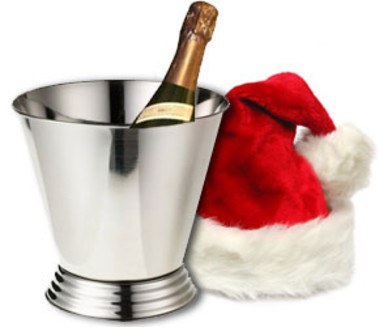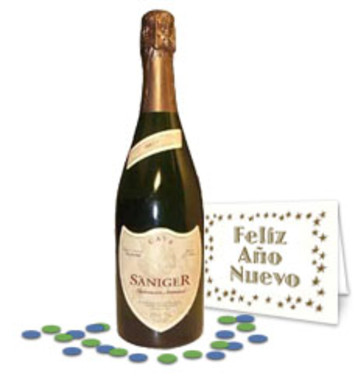Cava Uncorked: Sparkling Interest Abroad
December 19, 2005 - Brandchannel.com

Spain’s sparkling Cava is adored in its home country because it combines daily consumption habits into a celebration. The bubbly is beginning to get similar traction around the world. Though the Cava export market is dominated by companies like Freixenet and CodornÃu, other producers are figuring out methods to export this bottled happiness.
It seems to be a near given that bartenders and Cava producers would have some sort of sunshine-filled reason copied straight from a cheap Champagne ad on why the drink would be so loved in its home country.
Au contraire.
It turns out that people here are rather pragmatic about their drink of choice.
What’s the secret? Price.
In Spain (particularly in the Catalan region where most Cava is produced and consumed), the bubbly seems to run through the locals’ veins. (Selling for about two dollars a glass in a café, that becomes a distinct possibility.) At many tapas bars, it’s easy to get a sense of the “everyday” quality of the drink, as glasses are ordered as often as beer or wine. It also retains a cachet that causes heads to turn when a bottle is opened.
At Barcelona tapas bar Quimet & Quimet, owner Quim Pérez agrees. “Who drinks Champagne? People who have lots of money. Who drinks Cava? Everyone!”
“There are a lot of people in Spain who have never tasted Champagne,” he adds, clearly a bit proud of his countrymen, but also happy with the progress of the country’s own winemaking. “In the last ten years, people have begun to make some really outstanding Cava.”

He also agrees that price is the key. “People know there’s a difference between Cava and Champagne.” Cava tends to be a lot less sweet, for example. “And” he continues, “Champagne is excellent, but the biggest difference is price.”
For some smaller producers, cracking the market is all about bang for the buck, particularly when it comes to exporting.
“It used to be that everything that was good here was imported. It was cooler to get Champagne when you brought a girl out,” says Jaume Gramona, the director of Cava and wine producer Gramona S.A. “That’s not the case anymore.”
“Now, you can buy a couple bottles of good Cava for the price of one good bottle of Champagne,” he says.
The drink does so well here, in fact, that it has effectively reduced the Spanish sparkling wine market to two drinks. Other bubbly offerings such as French crémants or Italian spumantes are nowhere to be found.
Sure, Spaniards are willing to sell Champagne to anyone who wants to shell out anywhere between US$ 25 and $200 (and up) for a bottle, but with Cava as an option, most consumers seem to ask, “Why bother?”
“Price for price, the terrain is much more pitched in Catalans’ favor,” says Gramona.
This “low price, good quality” mantra has been the key to the success of Cava around the world. According to the Spanish Institute for Foreign Trade, Cava alone accounted for 7.4 percent of all wines exported from Spain in 2004. Three countries buy up the lion’s share of the Cava exports: Germany, the United Kingdom and the United States, which buy 40.2, 21.5 and 13 percent, respectively.
If Germany is any sort of bellwether, thoughts of any significant price hikes should be reconsidered.
“The day Cava starts costing more there, we’re in trouble,” Gramona says about exports to Germany, but there’s also a sense that this could be applied around the world.
Where smaller producers have more room to maneuver, especially in the United States, is with value. Wine-wise, Americans look for the most bang (or in this case, “pop”) for their buck, which is one of Gramona’s strong suits. The company also picked up on Americans’ willingness to fork over larger sums of money as long as the value is high.
When Gramona chose to go into the American market three years ago, its research on Spanish wines and Cavas wasn’t all roses.
“The Spanish Cava and wine market in the United States was going down three years ago,” says Gramona’s marketing director, Montse Alonso. “We noticed that though still wines were selling less, their value was going up.”
The population, she surmised, was looking for something good, not something cheap. “When people know about wine, they spend a lot of money on it,” she says.
The idea she brought back to Spain was to sell some of Gramona’s best stuff to the United States, not their base or middle-of-the-road-offerings, like most other Cava exporters were doing. It’s one thing to buy cheap sparkling wine and get what you pay for, but it’s much more impressive when you pay $30 and have your socks knocked off.
It hasn’t been easy. “It’s frustrating,” says Alonso. “There are some wineries in Catalonia that are exporting some of their worst stuff and it casts a negative image.” So for the last few years, Alonso has been living out of a suitcase in the United States for four months a year, to get the word out. “People who work with wine have heard about it, but most people just don’t know.”
For Gramona, cracking the market is a feat Alonso chalks up to what she terms “crazy traveling.”
“I go about two times a year for two months to show people what we do and introduce them to Cava,” she says. “Sometimes it’s two cities in a day.”
“It was hard to do, because we made more money selling the same wine in Spain,” she says, but the idea paid off. Three years after entering the US market, eight percent of Gramona’s exports now go to America.
Little by little, Cava is carving out a niche that’s not based on price alone, and this is especially felt at Cava maker Albet i Noya, which exports to 23 countries.
“The difficulty used to be in the price range,” says export manager Josep Jové. “There are huge brands like Freixenet and CodornÃu which tended to price things lower,” but along with Gramona, Albet i Noya has found its niche by providing wines of excellent value.
Jové is also happy to see that at least a few people are catching on to what Cava is in the United States. “I promote it as a high-quality sparkling wine,” he says. “I don’t want to give people the idea that it’s a Champagne substitute.”
Joe Ray is a Paris-based freelance journalist specializing in food and wine. He can be contacted via his Web site: www.joe-ray.com.